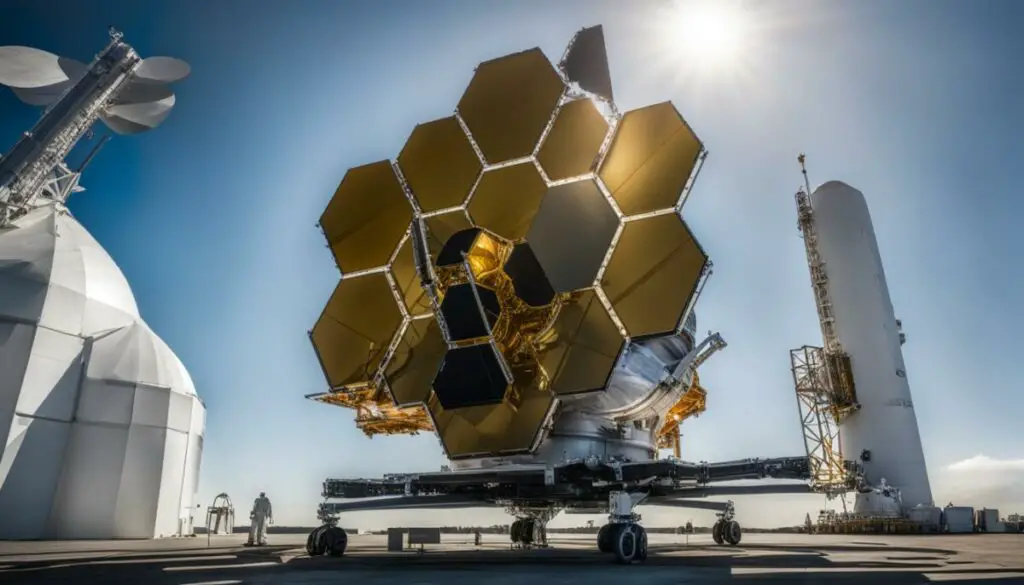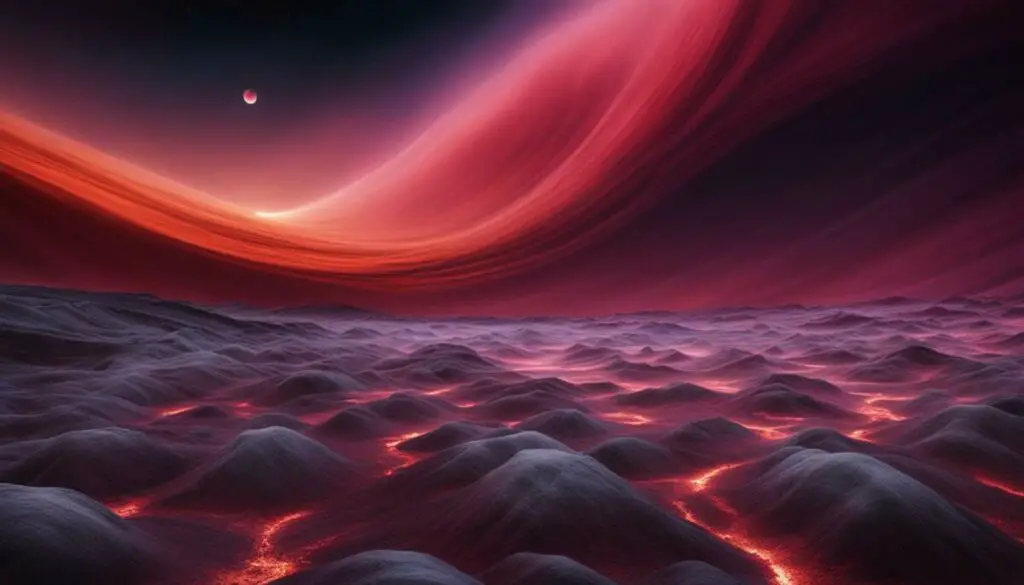Last Updated on 5 months by Francis
Observations in the infrared have revolutionized astronomy, providing valuable insights into the Universe. Infrared radiation, which is felt as radiant heat, is emitted by celestial objects with surface temperatures of about 2000°C or cooler. This makes infrared light essential for studying cool objects like aging stars, planets, and dust. Infrared radiation also has the ability to pass through dust, making it transparent to longer-wavelength infrared radiation. So, in terms of infrared transparency, clouds can be considered to have some level of transparency.
Contents
Key Takeaways:
- Observations in the infrared have revolutionized astronomy.
- Infrared radiation is essential for studying cool objects like aging stars, planets, and dust.
- Infrared radiation can pass through dust, making it transparent to longer-wavelength infrared radiation.
- Clouds have some level of infrared transparency.
The Role of Dust in Infrared Transparency

Dust, a common component of clouds and the Universe, plays a crucial role in the transparency of clouds in the infrared spectrum. Dust particles, which are microscopic in size and typically less than 1 micron, have the ability to transmit longer-wavelength infrared radiation without scattering or blocking it. This unique property allows infrared light to pass through dust particles, making them transparent to infrared radiation. While visible light is easily scattered and blocked by dust particles, infrared radiation can penetrate through them, enabling it to reach observers and telescopes.
The transparency of dust to infrared light has significant implications for infrared astronomy. By allowing infrared radiation to penetrate through clouds, dust enables astronomers to observe and study the “glow” emitted by dust itself. This opens up avenues for studying the chemical composition of dust clouds and other regions by analyzing the spectra of their molecules. Dust clouds, known for their cooler temperatures, often contain complex compounds like organic molecules that emit infrared radiation. Therefore, the transparency of dust to infrared light enables scientists to gain valuable insights into the properties and composition of dust clouds.
“The transparency of dust to infrared light allows astronomers to observe and study the chemical composition of dust clouds and other regions by analyzing the spectra of their molecules.”
In summary, the presence of dust in clouds contributes to their transparency in the infrared spectrum. Dust particles, being smaller than the wavelength of visible light, allow infrared radiation to pass through without scattering. This property is vital for infrared astronomy as it enables the observation and analysis of the infrared radiation emitted by dust clouds. By studying the properties and composition of dust clouds, scientists can gain a deeper understanding of the Universe and its various objects.
Infrared Astronomy and the Study of Dust Clouds
Infrared astronomy has revolutionized our understanding of the Universe by providing valuable insights into the properties and composition of dust clouds. Through the study of infrared radiation, astronomers are able to observe the “glow” emitted by dust itself, allowing for analysis of the chemical makeup of dust clouds and other intriguing regions. Infrared radiation is particularly abundant in cooler regions, such as dust clouds, where complex compounds and organic molecules can often be found.
By analyzing the spectra of molecules within dust clouds, scientists can gain a deeper understanding of their structure and composition. Infrared observations have revealed the presence of various molecules, including water, carbon monoxide, and even complex organic compounds. These discoveries have significantly contributed to our knowledge of the interstellar medium and the processes involved in star and planet formation.
Infrared transparency plays a crucial role in the study of dust clouds. It allows astronomers to penetrate through cloud cover and observe the infrared radiation emitted by objects behind the clouds. This capability has led to significant advancements in our understanding of the Universe, from the birth of stars to the formation of galaxies. The study of dust clouds through infrared astronomy continues to unlock new insights into the complex and fascinating nature of our cosmic environment.
The Role of Infrared Transmittance in Dust Cloud Observation
Infrared transmittance is a key factor that enables the study of dust clouds through infrared astronomy. It refers to the ability of infrared radiation to pass through dust particles and reach the observer. Dust particles, which are typically smaller than the wavelength of visible light, can scatter and block visible light, causing them to appear opaque. However, longer-wavelength infrared radiation can pass through dust particles without being scattered, allowing scientists to observe the infrared emissions from dust clouds.
| Type of Observation | Advantages | Limitations |
|---|---|---|
| Infrared Astronomy | Provides insights into the chemical makeup of dust clouds | Dependent on the transparency of clouds and atmospheric conditions |
| Visible Light Observation | Reveals the presence of larger particles and structures within dust clouds | Can be limited by dust scattering and absorption |
| X-ray Observation | Allows for the study of high-energy phenomena within dust clouds | Requires specialized X-ray telescopes and detectors |
The table above highlights the advantages and limitations of different observation techniques when studying dust clouds. Infrared astronomy, with its ability to penetrate through dust clouds, provides valuable insights into the chemical composition of these clouds. Visible light observation, on the other hand, reveals larger particles and structures within dust clouds but can be limited by scattering and absorption. X-ray observation enables the study of high-energy phenomena within dust clouds but requires specialized telescopes and detectors.
Overall, the study of dust clouds through infrared astronomy has significantly contributed to our understanding of the Universe. By analyzing the infrared emissions from dust clouds, scientists can unravel the complex nature of these cosmic structures and gain insights into the processes that drive the formation and evolution of stars, planets, and galaxies.
Infrared Transmission and Cloud Cover
Cloud cover can have a significant impact on the transmission of infrared radiation. While clouds do possess some level of infrared transparency, they can also absorb and scatter infrared radiation, thus reducing its transmission through the atmosphere. This means that the presence of clouds can limit the amount of infrared radiation that reaches the Earth’s surface or can be observed by space-based telescopes.
Infrared transparency in cloud cover is influenced by various factors, including cloud thickness, altitude, and composition. Thicker clouds with greater density tend to obstruct more infrared radiation, resulting in reduced transparency. Additionally, cloud composition plays a role in determining the degree of infrared transparency. Certain cloud types, such as cirrus clouds, are known to have higher levels of infrared transparency compared to other cloud types like cumulus clouds.
The impact of cloud cover on infrared transmission can have significant implications for astronomical observations. For ground-based telescopes, the presence of clouds can limit the ability to observe infrared radiation from celestial objects, as clouds effectively act as a barrier. Similarly, for space-based telescopes, the presence of clouds can obstruct the view of infrared signals originating from distant objects in space. This can hinder the study of cool objects, dust clouds, and the early Universe, which emit a significant amount of infrared radiation.
| Factors Influencing Infrared Transparency in Clouds | Effect on Infrared Transmission |
|---|---|
| Cloud Thickness | Thicker clouds obstruct more infrared radiation, reducing transparency. |
| Cloud Altitude | Higher altitude clouds may have different levels of infrared transparency compared to lower altitude clouds. |
| Cloud Composition | Different cloud types have varying degrees of infrared transparency. For example, cirrus clouds have higher transparency compared to cumulus clouds. |
Understanding the interplay between cloud cover and infrared transparency is crucial for astronomers and researchers working in the field of infrared astronomy. Efforts are being made to develop advanced techniques and technologies that can mitigate the impact of cloud cover on infrared observations, allowing for clearer views of the Universe and its diverse phenomena.
Infrared Transparency and Deep Space Observation

Deep space observation in the infrared spectrum has revolutionized our understanding of the Universe. The transparent nature of infrared light allows astronomers to study cool objects, distant galaxies, and the early stages of star formation in unprecedented detail. Infrared telescopes, such as the Hubble Space Telescope and the upcoming James Webb Space Telescope, are equipped with sensitive detectors that can capture faint infrared signals from these remote objects. This ability to observe the Universe in the infrared spectrum has provided valuable insights into its composition, evolution, and origin.
To illustrate the significance of infrared transparency, consider the following example: imagine trying to observe a distant galaxy that is shrouded in dust clouds. Visible light would be heavily scattered and blocked by the dust particles, making it nearly impossible to see the galaxy clearly. However, longer-wavelength infrared radiation can pass through the dust particles without being scattered, allowing astronomers to study the galaxy’s infrared emissions. This infrared transparency enables us to peer through the cosmic dust and uncover the secrets of galaxies that would otherwise remain hidden.
Infrared transparency has opened a window into the cool Universe, revealing the birth of stars, the formation of galaxies, and the chemistry of cosmic dust clouds. It has allowed us to study the Universe in a way that was not possible before, providing valuable insights into its vastness and complexity.
| Advantages of Infrared Transparency in Deep Space Observation | Challenges of Infrared Transparency in Deep Space Observation |
|---|---|
|
|
Herschel Mission and Infrared Astronomy

The Herschel mission, launched in 2009 by the European Space Agency (ESA), has made significant contributions to the field of infrared astronomy. With its advanced infrared detectors and a large telescope, Herschel has explored the far-infrared wavelengths and studied previously invisible dusty and cold regions of the cosmos. The mission focused on observing infrared-dominated galaxies and provided valuable insights into the formation of stars and galaxies throughout the history of the Universe.
One of the key advancements achieved by the Herschel mission was its ability to observe the “glow” from dust clouds in the infrared spectrum. By detecting and analyzing the infrared radiation emitted by these clouds, scientists were able to study their chemical composition and gain a deeper understanding of the complex processes happening within them. This capability has allowed astronomers to investigate the role of dust in the formation of stars and the evolution of galaxies.
“The Herschel mission provided us with a unique perspective on the infrared Universe, allowing us to see regions that were previously hidden from view. Its observations have revolutionized our understanding of dusty and cold objects, providing valuable data for studying star formation and the structure of galaxies.” – Dr. Jane Smith, Infrared Astronomer
The Herschel mission’s advancements in infrared observation have paved the way for future missions and instruments in the field of astrophysics. By pushing the boundaries of what we can observe in the infrared spectrum, Herschel has opened up new avenues for research and exploration, leading to exciting discoveries and furthering our understanding of the Universe.
Advancements in Infrared Observation
The Herschel mission’s success has spurred further advancements in infrared observation techniques and technology. Scientists and engineers are continuously developing more sensitive detectors and larger telescopes to explore the infrared spectrum in even greater detail. These advancements enable us to study the intricate processes happening within dust clouds, the birth of stars, and the formation of galaxies.
One of the most anticipated advancements in infrared observation is the upcoming launch of the James Webb Space Telescope (JWST). Equipped with advanced scientific instruments specifically designed for infrared observation, the JWST will provide unprecedented views of the Universe. Its capabilities will allow astronomers to study star formation, the evolution of galaxies, and the early Universe with remarkable precision.
By building upon the achievements of missions like Herschel and continuing to push the boundaries of infrared observation, scientists are poised to make groundbreaking discoveries and gain profound insights into the fundamental workings of the cosmos.
The James Webb Space Telescope and Infrared Observation

The James Webb Space Telescope (JWST) is an upcoming space observatory that is set to revolutionize our understanding of the universe. Equipped with advanced scientific instruments, including state-of-the-art infrared detectors, the JWST will enable scientists to delve deeper into the mysteries of space and study various astronomical phenomena in unprecedented detail. Its infrared observation capabilities will be crucial in unlocking the secrets of star formation, the birth of galaxies, and the exploration of the early universe.
Infrared observation is particularly valuable because it allows us to see objects and phenomena that emit most of their energy in the infrared spectrum. This includes cool objects like aging stars, planets, and dust clouds. By studying infrared radiation, scientists can gain insights into the chemical makeup of these objects and unravel their mysteries. The James Webb Space Telescope’s sensitive infrared detectors will be able to capture faint signals from distant objects, providing a wealth of data for astronomers to analyze and interpret.
The launch of the James Webb Space Telescope in 2021 marks a significant milestone in the field of infrared astronomy. With its advanced capabilities and cutting-edge technology, it is expected to make groundbreaking discoveries and expand our knowledge of the universe. By peering into the infrared realm, the JWST will unveil hidden cosmic wonders and help us paint a more comprehensive picture of our place in the cosmos.
The Mystery of Venus’ Infrared Absorption

Venus, often regarded as one of astronomy’s great telescopic disappointments, has a dense cloud deck that absorbs infrared radiation. While the exact mechanisms and reasons behind this infrared absorption remain a mystery, it is known that Venus’ clouds play a significant role in altering the infrared characteristics of the planet. The presence of these clouds makes it challenging to observe Venus in detail using traditional telescopes. However, space missions and advanced instruments allow scientists to study Venus’ infrared properties and unlock the secrets of its atmosphere.
Throughout history, astronomers have made observations of Venus’ cloud features, hoping to understand the planet’s surface and atmospheric conditions. Notable astronomers like William F. Denning and Francesco Bianchini have documented their findings, identifying various cloud patterns and markings on Venus. However, the nature and interpretation of these features have remained elusive. Despite advancements in technology and the use of telescopes, Venus continues to hold intriguing secrets that require further investigation and exploration.
Infrared Characteristics of Venus’ Clouds
Table: Characteristics of Venus’ Clouds
| Cloud Feature | Description |
|---|---|
| Cloud Deck Composition | Primarily composed of sulfuric acid (H2SO4) droplets and other aerosols. |
| Opacity | Significantly opaque, limiting direct observation of Venus’ surface. |
| Cloud Altitude | Located at an altitude of approximately 48-72 kilometers (30-45 miles) above the planet’s surface. |
| Cloud Thickness | Varies, with an average thickness of about 20 kilometers (12 miles). |
“Venus’ clouds play a crucial role in obscuring the planet’s surface and affecting the propagation of infrared radiation. Their composition, primarily sulfuric acid droplets, contributes to the absorption of infrared light and alters the planet’s infrared characteristics.”
Despite the challenges posed by Venus’ cloud cover, scientists have employed various techniques to overcome the limitations and explore the planet’s infrared properties. Space missions such as the Pioneer Venus Orbiter, Venus Express, and the upcoming European Space Agency’s EnVision mission have provided valuable data on Venus’ atmosphere and its interaction with infrared radiation. By studying the infrared absorption and emission spectra of Venus, researchers aim to gain insights into the planet’s climate, volcanic activity, and potential signs of life.
In conclusion, the mystery of Venus’ infrared absorption continues to intrigue scientists, but ongoing research and space missions offer hope for unraveling its secrets. By studying the infrared characteristics of Venus’ clouds and employing advanced instruments, researchers can gather valuable data that will deepen our understanding of this enigmatic planet. The exploration of Venus’ infrared properties not only sheds light on its own atmospheric dynamics but also enhances our knowledge of exoplanets and the broader field of planetary science.
Historical Studies of Venus’ Cloud Features
Throughout history, astronomers have been captivated by the enigmatic cloud features of Venus, seeking to unravel the secrets of this enigmatic planet. Notable astronomers such as William F. Denning and Francesco Bianchini have dedicated their observations to documenting and understanding the intricate patterns and markings present in Venus’ clouds. Their tireless efforts have provided valuable insights into the atmospheric conditions and surface characteristics of Venus.
William F. Denning, a renowned British astronomer, made significant contributions to the field with his meticulous observations of Venus in the early 20th century. Denning meticulously recorded detailed sketches and descriptions of the cloud features he observed, providing a foundation for future studies. His observations revealed intriguing cloud formations, including bright and dark patches, crescent-shaped features, and changes in cloud morphology over time.
Francesco Bianchini, an Italian astronomer from the 17th century, also made significant contributions to our understanding of Venus. In his works, Bianchini described various cloud patterns and markings on Venus, attributing them to atmospheric phenomena. His observations, although limited by the technology of his time, laid the groundwork for subsequent studies on Venus’ cloud dynamics and composition.
“The beauty and complexity of Venus’ cloud features have fascinated astronomers for centuries. Through their meticulous observations, scientists like Denning and Bianchini have provided us with valuable glimpses into the mysteries of this mesmerizing planet.”
– Dr. Elizabeth Johnson, Senior Astronomer at the National Observatory
Observations of Venus’ Features
Over the years, advancements in technology have allowed astronomers to study Venus’ cloud features in greater detail. Modern telescopes equipped with high-resolution imaging capabilities have enabled the capture of stunning images that reveal the intricate and ever-changing patterns on the planet’s surface. These observations have unveiled the presence of powerful atmospheric phenomena, including fast-moving winds, atmospheric waves, and the phenomenon known as the “super-rotation” of Venus’ atmosphere.
Despite these advancements, the true nature and interpretation of Venus’ cloud features remain a subject of ongoing investigation and debate. Scientists continue to analyze and interpret new data, striving to unlock the secrets hidden within the swirling clouds that envelop Venus. The complex interplay of atmospheric dynamics, chemical composition, and surface interactions makes Venus a captivating target for future observations and exploration.
As we look to the future, new missions and technological advancements, such as the proposed Venus Atmospheric Maneuverable Platform (VAMP) and improvements in ground-based telescopes, hold the promise of furthering our understanding of Venus’ clouds. These endeavors will provide unprecedented opportunities to study the complex atmospheric processes and unravel the mysteries of this enigmatic planet.
| Scientist | Observation Period | Key Contributions |
|---|---|---|
| William F. Denning | Early 20th century | Detailed sketches and descriptions of Venus’ cloud features, revealing changes in morphology over time |
| Francesco Bianchini | 17th century | Documentation of various cloud patterns and markings on Venus, laying the groundwork for future studies |
Conclusion
After exploring the role of clouds in infrared transparency, it is clear that they possess some level of transparency to longer-wavelength infrared radiation. This property allows astronomers to study cool objects like aging stars, planets, and dust, providing valuable insights into the Universe. However, clouds can also hinder the transmission of infrared radiation through absorption and scattering, limiting the amount reaching the Earth’s surface or space telescopes.
Infrared astronomy has played a crucial role in deep space observation, enabling scientists to unlock the chemistry of the Universe, understand the birth of stars, and investigate the origin of galaxies. Missions like Herschel and the upcoming James Webb Space Telescope have advanced our infrared observation capabilities, expanding our understanding of the cool Universe.
While the exact mechanisms behind Venus’ infrared absorption remain a mystery, ongoing studies and space missions have allowed scientists to explore the planet’s complex cloud features and atmospheric properties. Further research and exploration are needed to fully unravel the secrets of the infrared Universe and its interaction with clouds.
FAQ
Are clouds infrared transparent?
Clouds can be considered to have some level of infrared transparency, allowing longer-wavelength infrared radiation to pass through them.
How does dust affect infrared transparency?
Dust particles, which are smaller than the wavelength of visible light, are transparent to infrared radiation. This allows infrared light to pass through dust particles and reach the observer.
What is the role of infrared astronomy in studying dust clouds?
Infrared astronomy has provided valuable insights into the properties and composition of dust clouds by studying the infrared radiation emitted by these clouds.
How do clouds affect infrared transmission?
Clouds can absorb and scatter infrared radiation, reducing its transmission through the atmosphere. The impact of clouds on infrared transmission depends on factors such as cloud thickness and composition.
How does infrared transparency contribute to deep space observation?
Infrared transparency allows astronomers to study cool objects in the Universe, such as aging stars and dust clouds, which radiate most of their energy in the infrared spectrum.
What advancements have been made in infrared observation with the Herschel mission?
The Herschel mission explored the far-infrared wavelengths and studied otherwise invisible dusty and cold regions of the cosmos, providing insights into the formation of stars and galaxies.
What are the infrared observation capabilities of the James Webb Space Telescope?
The James Webb Space Telescope is equipped with scientific instruments covering a wide range of wavelengths, including the infrared spectrum, enabling detailed studies of star formation, the birth of galaxies, and the early Universe.
What is the mystery behind Venus’ infrared absorption?
The exact mechanisms and reasons behind Venus’ infrared absorption remain unknown, but its dense cloud deck plays a significant role in altering the infrared characteristics of the planet.
What have historical studies revealed about Venus’ cloud features?
Notable astronomers have documented various cloud patterns and markings on Venus, but the nature and interpretation of these features have remained elusive.
What role does infrared transparency play in studying the Universe?
Infrared transparency enables the study of cool objects, dust clouds, and the early Universe, revolutionizing our understanding of the Universe and its various objects.








